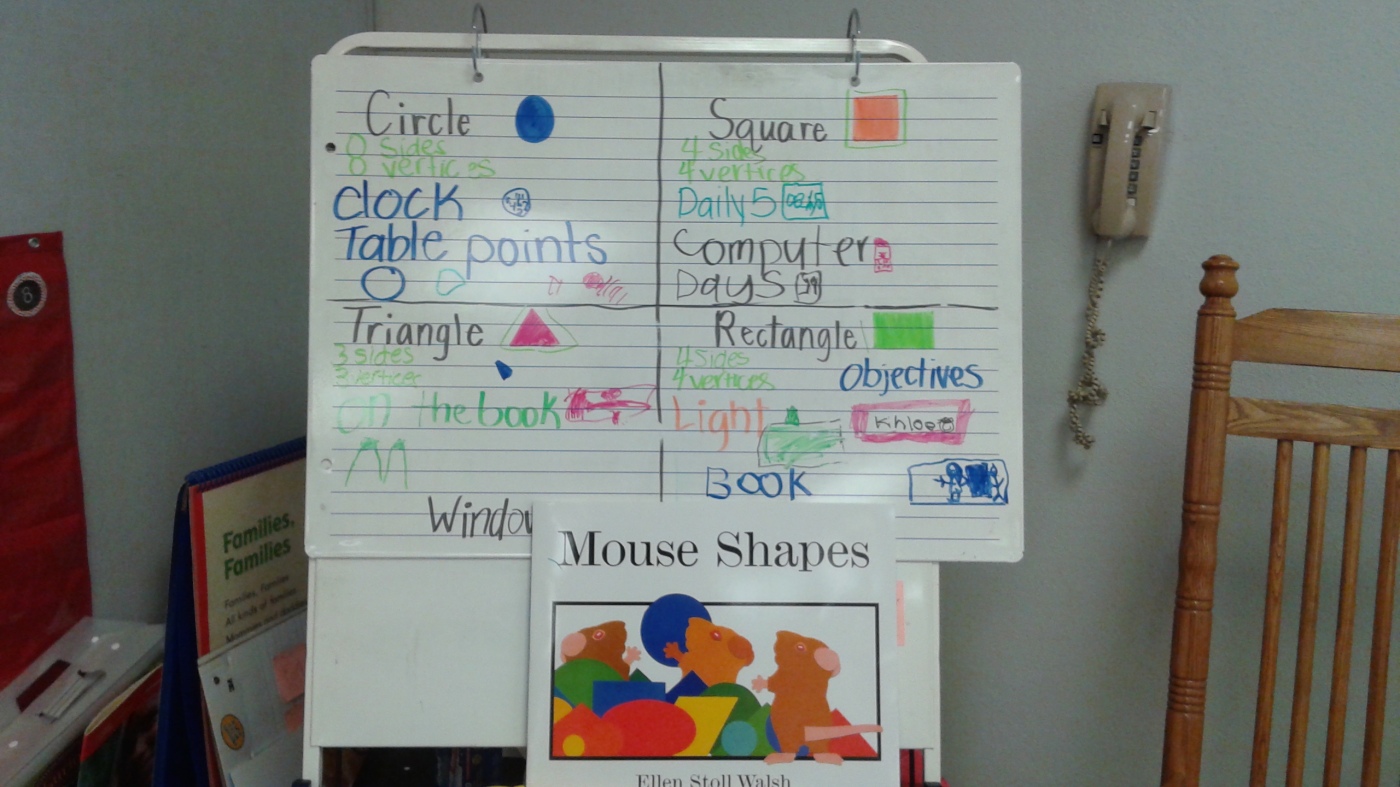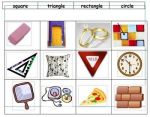On October 18th, I taught a shapes lesson on my kindergarten class. Within this lesson, the students focused on the 2-d shapes: triangle, circle, square, and rectangle. Prior to teaching this lesson, I gave the students a pre-assessment in which the students cut and pasted real world images by the 2-d shape they are most similar too. In this pre-assessment, I was able to see any misconceptions that the students had about rectangles and squares, and circles and ovals. It also showed me what students were able to recognize shapes and be able to match the correlating shapes. From this assessment, I adjusted my lesson to ensure I explicitly teach misconceptions.
There were some things I liked about this lesson, and there were some things I think I could have done better. One of the strategies I liked was the shape hunt chant. The students thoroughly enjoyed this chant because they were able to get up and do movements while chanting and looking for shapes. From watching the video, I saw that the students were all actively engaged during this part. The chant and movement was where I made my connection to another course I’ve taken. In my ESOL course, we learned about the ESOL strategy jazz chants. Within these, you (as the teacher) say each lyric one at a time allowing students to repeat it after. This allows the students (who may not be fluent in English) to be able to actively participate. Additionally, another thing we learned in ESOL was total physical response (TPR). In this strategy, students correlate movement with words (Diaz-Rico & Weed, 2010). In the shape hunt chant I did, the students did movements while chanting. I have an ESOL student in my classroom and I am particularly interested in ESOL so being able to use these strategies advantages my student and my practice. However, even though these are ESOL strategies, they support all of the students thinking and provides good foundations for their learning. Another thing I liked during my lesson was the quick reflection response I had. After doing the chant for the first time, I didn’t have the students sit down in order to fill out the class shape chart. I noticed that the students got a little antsy when we were sharing what things they saw that was a certain shape. I’m glad I was able to recognize this and reflect quickly to make the small adjustment of having the students sit down while doing the chart. Something that I wish I would have done differently was to use a different book. The book that I used was one my CT had. Since I couldn’t find a book at the USF library to use on Monday, I used what as available. The thing I didn’t really like about it was that it didn’t talk about sides and vertices. Another thing I would have done differently was to use a bigger chart. We only wrote three objects in each shape box and we still had to cram the words and pictures in, making it a little disorganized. Another strategy I would have liked to incorporate is manipulatives. The students could have felt them in their hand while we were discovering the number of sides and vertices. This could have supported their visual and kinesthetic understanding of the shapes. In my math class we learn about giving students multiple different opportunities and chances to learn content through various strategies. Not all students learn the same way and because of that, I’ve learned that giving students different opportunities to learn math provides them with equity to learn. These multiple strategies technique is in line with the standards because it is showing students the reasoning behind math with all the different visual ways to represent it (Van De Walle, Karp, & Bay-Williams, 2013).
The aspects of the lesson that was done differently then I had planned was the mentor text used and the clearness of directions. I had planned on finding a book that was more informational then just fun. I think a book that talked about the attributes of the shapes would have been a good addition to the lesson. I have been really trying to make my directions as explicit as possible. Even though my CT said that my directions were alright, I think I could have done a better job because some students were still a little confused as to what they needed to do.
The part that surprised me about the lesson was the pure enjoyment that the students had while doing the shape hunt. During the triangle search, I warned the students that this one was tricky because there weren’t a lot of them in here. One of the students pointed out the triangle made in the capital A. I never even thought of that triangle when I was pre-planning, so I was genuinely surprised from this students keen eye.
In order to see if the students learned from this lesson, I had the students fill out an exit ticket. They were to draw something that we saw was the shapes we worked on in class. I was able to see what students understood the lesson as far as what objects make a particular shape and which don’t. I was also able to see what accommodations I needed to make for my lesson activity tomorrow, in which they were to work collaboratively. I wanted to pair the students in heterogeneous groups in which they were able to be supported from each other in the group. There were students that had a difficult time with the exit ticket because I expected them to write words of what they drew a picture, however, there are some students who are still working on their writing stills. Therefore, those students didn’t write any letters and struggled with articulating their thinking. Seeing this, I was able to adjust my groups for the next days lesson.
References:
Diaz-Rico, L. T., & Weed, K. Z. (2010). The crosscultural, language, and academic development handbook: A complete k-12 reference guide (4th ed.). Boston, MA: Pearson Education.
Van De Walle, V. A., Karp, K. S., & Bay-Williams, J. M. (2013). Elementary and middle school mathematics: Teaching developmentally(4th ed.). Upper Saddle River, NJ: Pearson Education.












Recent Comments